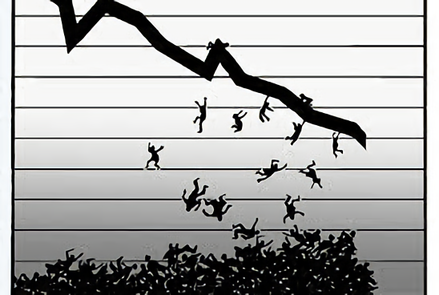Nature of Financial Crisis – 1st Chapter

Introduction
Although the origins of the studies on crisis theories date back to the 1800s, it is not possible to talk about financial crises in the sense we know today for that period. Hence, crisis theories were initially developed to explain real economic crises. On the other hand, from the beginning of the 1940s to a large extent II. In line with the preparations for World War II, the economic revival led by the war industry and centered in the USA expanded from 1947-48 to include many OECD countries and this growth conjuncture continued almost uninterrupted until the early 1970s. In contrast to this growth conjuncture, there was a natural pause in the crisis theories discussions. However, in the early 1970s, with the collapse of the Bretton Woods (BW) system and the impact of the oil shocks, the conjuncture changed its direction again, and parallel to this, the discussions on crisis theories were re-ignited. However, with the intensity of international financial globalization activities in the 1970s, many developing and developed countries started to experience financial crises. Even though the crises experienced in the 1980s and after period differ more or less, the main characteristics are currency crises. As a natural consequence of this change in the world economy, discussions and studies have been carried out since those years, including topics such as financial crisis, its types, and reasons rather than real economic crisis theories. Meanwhile, the explanation and prediction models of monetary crises have created an important archive within this area of interest. For this reason, real economic crisis theories and models of major monetary crises are also included in the study. It is called negative developments that occur suddenly and unexpectedly. The word crisis is rooted in “decision making” instead of “crisis”. (Duman, 2011: 3). It has a widespread use in medical sciences as a symptom of sudden onset of illness. “In social sciences, on the other hand, sudden deterioration means great distress, and depression. ” (Aktan and Şen, 2001; 1225). The situation where the deterioration affects the production of the administrative state by microorganisms is economic (Aktan et al. 2001; 1225). To call such a situation an economic crisis, it must contain some crises. First of all, it should not be forgotten that the crisis is a period of sudden, unexpected, rapid and radical change. When societies in economic crisis look back, they see nothing like before. “The idea that it is impossible to see the future must be fired up in these societies. ” (Yıldızoğlu, 1996; 326). Problems that do not appear unexpectedly, that progress in a certain monotony and that have become chronic, do not always mean a crisis. In the natural course of the conjuncture, routine inflation, deflation situations, devaluation or revaluation do not mean anything on their own (Aktan et al. 2001; 3). For example, translation is a problem for both the state, individuals and firms, but the prices are not It can be said that the first major hyperinflation in history took place in Europe, which carried the mines of the Americas as a result of geographical discoveries. Likewise, depression is a crisis in which the general level of prices falls suddenly and unexpectedly while deflation is a problem. Grow in the 1929-1933 accumulation Big Depression; It was a time when the economy of depression was truly experiencing. In the history of economic crises, we can classify the crises before and after by accepting the 19th century as the milestone. Before the Industrial Revolution, famine crises caused by insufficient harvests or inflation crises due to government intervention were evident due to the agriculture-based economy. The trade between the 16th and 18th centuries, the most dynamic sector of the European economy. In the first half of the 19th century, the manufacturing industry products were able to find the widespread possibility of production and distribution in Europe.
Chapter 1
In the eyes of economists, crises (the first observed industrial crises) are accidents that occur accidentally during the development of capital accumulation as a fundamental phenomenon. This is the same for the neoclassical school established at the end of the 19th century, inspired by the work of the English economist W. S. Jevons (1871), the Austrian economist C. Menger (1871), and especially L. Walras (1874), the founder of the general equilibrium theory. In the structure of the neo-classical model, equilibrium is theoretically automatic, so the crisis is logically impossible, it is not possible to conceptualize it because the object does not exist. The imbalances observed in practice, crises, in particular, may arise from external factors that are supposed to play a role in protecting the equilibrium, but in reality, hinder the functioning of the free market economy. State interventions, wage policies, and trade unions obstruct the functioning of the labor market, according to these economists. According to them, the fact that there is a surplus of labor (unemployment) should lead to the general level of wages falling, which is the only valid process to achieve full employment. Crisis can only occur accidentally, regardless of the functioning and nature of capitalism. In the neo-classical model, the “denial of the existence” of the crisis has created a void that leaves no original structure. Despite all these explanations, when the historical significance and periodicity of classical crises are known, this “gap” is an important point to be highlighted. Again in this context, D. Ricardo accepts the crisis of 1816, which is accepted as the first crisis by historians, as a coincidental event. Ricardo’s main argument on this issue is J. B. Say’s “Geographical Law”. Accordingly, goods are exchanged for goods, each supply creates its own demand, all production is consumed. Because the value of the production is equal to the value of the distributed income. So it is equal to purchasing power. In this case, the crisis is an accidental phenomenon.
The capitalist system has encountered serious economic crises quite frequently throughout the historical process. The most important of these in the process up to now is undoubtedly the world crisis in 1929. The stock market collapsed, the collapse spread to the world in a short time and the great depression that continued for ten years followed. In 1933, the GNP was about two-thirds of the value in 1929. In 1933, about thirteen million people lost their jobs. In 1938, one in five people was still unemployed. Again in this period, prices decreased by around 25%. In short, the crisis process caused serious damage in many countries, especially the USA, in terms of its effects and consequences, and it took a long time to repair these damages. (Galbraith, 2009: 177-190). The concept of crisis has entered our lives much more after the 1990s. In the 1990s, with the globalization and transparency process in the financial markets in the world, the development of inventions and innovations in information technology in financial techniques and tools has added different dimensions to the crisis. In particular, the impact of innovations in computer and information technology on financial instruments and financial services and the enormous increase in new financial instruments facilitated the acceleration of capital flows, but also played an accelerating role in spreading and perceiving crises.
When we look at the crises experienced in the world so far, it is seen that they have many common features, but no crisis is the same (Perelman, 2008: 30). Although there are many common features in all of them, it is possible to say that their prominent features and their relative weights are different. The striking feature of the financial crises that have emerged in recent years is that they have caused great damage both in developing and developed countries. The ERM crisis (1992-1993), which emerged in the European Union countries in the early 1990s and was a currency crisis, can be shown as an example of the crises in developed countries. While this crisis is a crisis stemming from tight monetary policies, the Mexican crisis (1994-1995) is over-consumption and the Asian crisis (1997-1998) is an over-investment crisis (Yay et al., 2001: 15-30). However, it is seen that they share some common features besides these differences. All three were not caused by problems in basic macroeconomic variables, but rather from fixed, semi-fixed, and exchange rate systems based on a common currency, excessive appreciation of the real exchange rate, insufficient international liquidity, and massive capital inflows/outflows. However, the severity of the factors and their manifestation is quite different. In addition to these factors, banking sector problems/weaknesses played an important role in Mexico and Asia. The dominant factor in the Brazilian Crisis (1999) is the defects in macroeconomic fundamentals. (Moreno and Trehan: 2000) Crisis in Turkey (2000-2001) If there has been a significant share of all the factors in the crisis of the last. In short, although the crises of the 1990s have many common features, no one crisis is the same. It is seen that the financial liberalization process in developing countries took shape in the 1990s. The basis of the regulations for liberalization in the real and financial sectors is to create a sustainable growth process by accelerating the functioning of the market mechanism in the system and accordingly to increase the welfare of the country. Also; Liberalization in the real and financial part of the economy has traditionally been frequently suggested by the World Bank (IBRD) and the International Monetary Fund (IMF) in order to eliminate or reduce economic distortions. In this framework, it is observed that the inter-country integration process has accelerated in international real and financial markets. From this point of view, important developments in terms of both the amount and composition (the increase in the share of portfolio investments) in the capital flow towards developing countries, especially in the 1990s, explain very well how this integration process developed. It is argued that the basis of this process is the high-interest low exchange rate (fixed exchange rate system) implementation in many developing countries.
It is understood from the high growth rates of these countries that this integration process had positive results in developing countries until the first half of the 1990s. But; It is seen that this process has been interrupted since the second half of the 1990s. In other words; Developing countries, especially the countries of Asia and Latin America, have experienced negative economic developments along with financial crises in the form of monetary crises that emerged during their integration process. Many economists, along with the domestic economic policies applied,
It examines the cyclical process (expansion-contraction) experienced by these countries within the scope of liberalization and adopts crisis forecasts as a subject of study in order to alleviate the effects of crises on the economy. In other words, theoretical models have been developed in order to explain the crises experienced as a result of the discussions in this field and to reveal their reasons, and many empirical studies have been made within the scope of these models. According to these studies; With the adoption of the fixed exchange rate system, the arbitrage opportunity created by high-interest rates and the capital flows towards developing countries as a result of rapid financial liberalization initiatives create a crisis process in the economy through two channels. The first of these is that the overvaluation of the national currency together with the above-mentioned fact causes the deterioration of the trade balance as a result of the decrease in the export growth rate and the increase in the import growth rate, and the increase in the current account deficit causes the balance of payments problems. The second channel, again with the same phenomenon, is that the banking system can borrow easily from abroad, the increase in the external liabilities of the banking sector, the increase in the private sector loans (excessive borrowing), the increase in asset prices, and the emergence of the unhealthy banking system as a result of the weakening of the banking sector’s risk perception. is an increase in fragility.
Zeki Talustan Gülten



